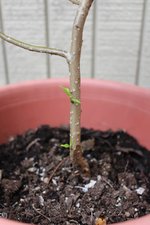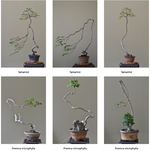Not familiar with those two pathogens but both have poplar-affecting (incl. cottonwood) subspecies. The latter of two is said by OSU (as in Oregon state) to not be a major threat to health as you suggested. OSU says both will be treated by things like Bonide and Daconyl but... if it were me, I would still hestitate to treat unless I knew I had a "real-real" problem.
This "real-real" is admittedly hard to judge because from what I've seen, a very strong healthy cottonwood can shed uncompetitive foliage mid-season. Uncompetitive means either shaded out / deep in the interior, it could come in the form of a weak tip flush on an older branch that hasn't produced a run this year. It can mean any small weak growth that coexists on the same tree as very strong/surging growth. In the process of shedding, you can get spooked because those leaves succumb to attacks as soon as the tree has lost interest in them, and they're still hanging on the tree.
So if you have very strong running tip growth somewhere with expanding leaf size, but meanwhile weaker foliage on older branches is showing spots, maybe the issue isn't actually disease per se and more of a matter of imbalance. Cottonwoods (poplars & willows generally) are brutal in this way. You can see full size adult ones going through the same process and if you have a grove nearby that blends between a sunny/open area and a wet/darker area, the cottonwoods in the wet darker area will be shedding more aggressively in the midseason in favor of their upper canopy. There is lots of ugly leaf activity down at the base of my nearby ravine, but if you take a drone above 50-75ft (or encounter a branch that fell down from way up above), leaves from the very same trees look flawless.
If I was looking at your tree in person I might first try to judge if this is "just" a case of weak zones vs. strong zones and midseason shedding or something more global to the whole tree.
You can also see ugly foliage succumbing to things at the tail of leafdrop season too, when they're already abandoned by the tree but still on the tree. In Oregon at least, very strong adult cottonwoods in mountain areas seem to defend better at this (i.e. maintain an aspen-like golden leaf) than in the valleys where fall is much warmer and a pathogen can attack the still-attached but already-abandoned leaf.
The other known pathogen that is similarly "not a big deal" (as far as OSU says) is cottonwood/aspen rust which produces splatter patterns of very saturated/bright orange fungal growth on the undersides of leaves. In some years I have seen this (not just on my own tree but everywhere in entire area I live in), but in most years I don't see hardly any of it anywhere near me. In the years where I have seen it, I've seen it on cottonwoods that are growing very strongly, even on the strong growth. It didn't impact health and I haven't tried to treat it yet. As I have more cottonwoods moving out of coarse and into fine growth, I am tempted to apply a systemic at bud break, but I'm uncertain if it'll be effective due to the high prevalence of both this pathogen and a big population of cottonwoods all around me -- the soup cottonwood material borne by wind is nearly constant (twigs/leaves/cotton puffs). One of the challenges of growing a locally native species while embedded in a large population of them.
If you do go ahead and treat I'd be interested to hear how that goes.










